From Trash to Treasure: The History of BBQ Ribs
Far from being a delicacy that traces its roots to the antebellum South, barbecue ribs are a 20th-century innovation.
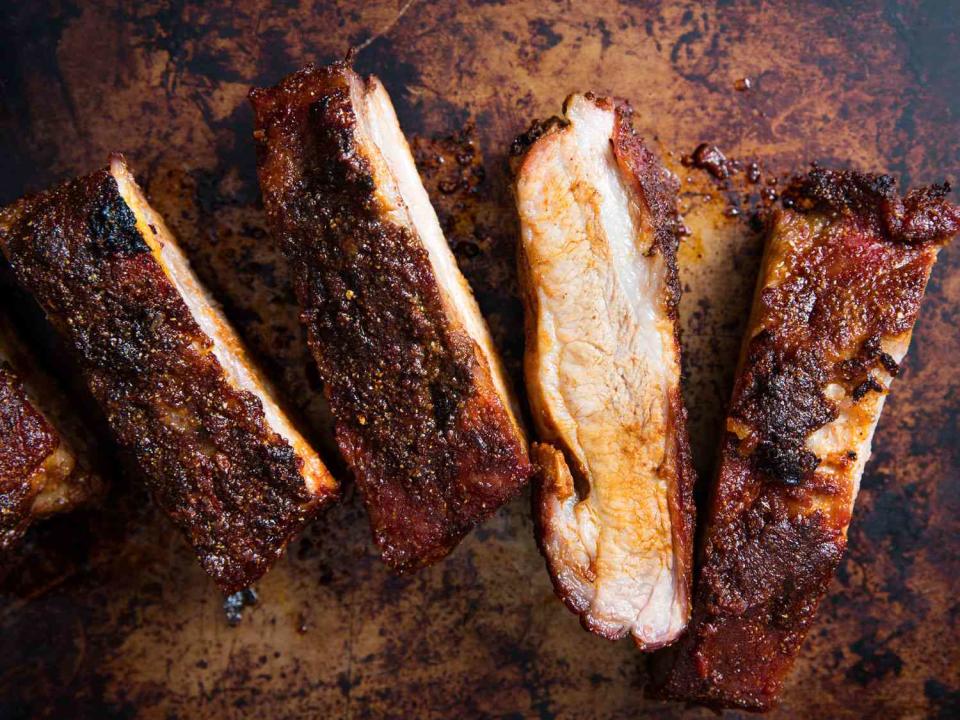
Serious Eats / Vicky Wasik
Pork ribs are a staple of American barbecue. Memphis is famous for its dry-rubbed version, and rib tips are a staple at Chicago’s South Side barbecue joints. Even down in beef-centric Texas, pork ribs are in high demand, constituting one-third of the state’s "holy trinity," along with brisket and sausage.
But that hasn’t always been the case. Historically speaking, ribs are relative newcomers to the pits. Nonetheless, many writers have erroneously assumed that the antebellum South was their likely place of origin. This explanation by Meathead Goldwyn of AmazingRibs.com strikes the standard chords that have led some people to assume barbecued ribs were a product of that time: "In the pre-Civil War South, [slavemasters] got to eat the best cuts of meat. They ate the tenderloin from along the pig's back, ‘high on the hog’ (yes, that's where the expression came from), while the slaves got the tougher, more gristle-riddled cuts."
But no one was putting slabs of ribs on barbecue pits back in the 19th century. Instead, barbecued ribs are an early 20th-century innovation, one driven not by the distribution of pig pars on a plantation but by the rise of industrial meatpacking, mechanical refrigeration, and commercial barbecue stands. And our barbecue menus are richer (and our fingers stickier) as a result.
The Whole Hog
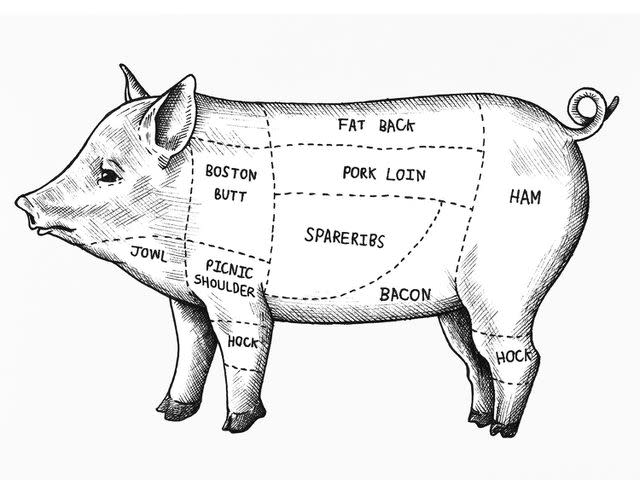
It’s easy to forget how dramatically mechanical refrigeration and railroad transport changed the way Americans eat—especially when it comes to meat. Fresh meat from larger livestock like pigs and cows wasn’t available year-round before the Civil War, because there was no way to keep it from spoiling. Farmers had to wait until the first cold winter weeks to slaughter their pigs; it needed to be cold enough—below 40°F or 4°C—for the carcass to cool quickly and not spoil, but also not so cold that the meat would freeze.
A hog killing on a 19th-century farm was a laborious but celebratory event, with the whole family and plenty of neighbors and friends pitching in. Almost every part of the pig was put to good use. The blood was reserved for puddings and the fat rendered into lard in giant kettles. Smaller scraps of meat and fat were ground into sausages, and the heads and feet were boiled to make "souse meat" or rendered into a thick, savory stew—hash and rice, South Carolina’s traditional barbecue side dish, evolved from these hog-killing stews.
The carcasses were then allowed to chill overnight and the next morning were cut into hams, shoulders, and "middlings" (side meat or bacon), which were taken to the smokehouse and preserved by curing and smoking. The parts left behind—the chine (backbone), the tenderloins, the chitterlings (intestines), and the ribs—were eaten over the next few days.
Those traditional hog-killing dinners featured fresh roasted spare ribs and chine served with bread, potatoes, apple sauce, and cabbage or greens. And they might well be the only fresh pork a farm family enjoyed all year. They couldn’t have a hog killing during the summer—especially not in the South—for the meat would spoil in the sweltering heat long before they finished all the butchering, lard rendering, and sausage-making.
There was one exception to this, though. At big events, where the entire community gathered, farmers could take a few pigs to a shady grove where a barbecue pit awaited, slaughter them and remove the entrails right on the spot, and put the whole animals on the pit to cook. And that’s exactly what a 19th-century barbecue entailed.
Barbecue originated not as a way of "making do" with lesser cuts, but rather as a method of whole-animal cookery—one usually staged for a large crowd. I’ve been unable to find any accounts that describe enslaved people (or anyone else, for that matter) cooking ribs or other individual cuts on a barbecue pit. Plenty of primary sources, however, describe or illustrate whole carcasses of pigs, goats, lambs, and even cows being cooked over a bed of coals in pits dug in the ground. When people in the 19th century ate barbecued ribs, they pulled the meat from a whole pig that was already cooked.
The Meat Packers’ Cast Offs
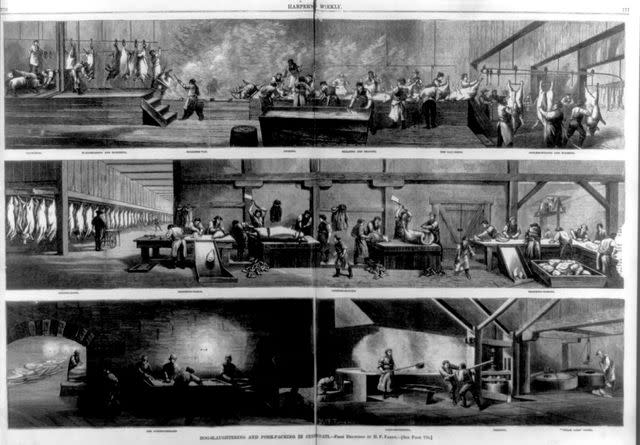
This doesn’t mean that no one ate spare ribs in the 19th century—they just weren’t barbecuing them. As the century advanced, ribs became available in greater and greater quantities, provided you lived in the right place—namely, a city like Indianapolis or Louisville, where hogs were being packed and processed to ship around the country.
Industrial pork packing arose in the early decades of the century, driven first by improved river navigation and then by the expansion of railroads. Cincinnati, blessed with a prime position on the Ohio River and close to burgeoning cornfields and hog farms, emerged as "Porkopolis," the largest pork-producing city in the world at the time.
By 1836, Cincinnati’s four largest slaughterhouses were collectively killing and butchering some 2,600 hogs in a single day, producing between 200 and 500 barrels of pork along with 200 kegs of lard. In these early days, the tools and procedures used to slaughter a hog in a commercial setting were not so different from those of a rural hog killing; it was just conducted on a much larger scale, with each step—dispatching the pig with a blow from a hammer, scalding the carcass in boiling water, scraping the hair away—performed by a different worker, on an assembly line of sorts.
Barrels were essential to the pork trade. With no means of refrigerated transport, packers had to preserve the meat before shipping, but they didn’t want to waste weeks slow-smoking it like farm families did. Instead, they packed the hams and shoulders in barrels, filled in the gaps with chines, hocks, and jowls, then poured in a sweet and salty "pickle" made from rock salt and brown sugar boiled in water.
The spareribs didn’t fit in the barrels, and packers found themselves with literal tons of unwanted racks on their hands. "It is said that during the hog-killing season in Cincinnati," the New Orleans Times-Picayune reported in 1844, "any keeper of a boarding-house, by sending a basket to the butcher’s, can have it filled with the finest and most delicious spare ribs, and ‘free gratis for nothing’ at that."
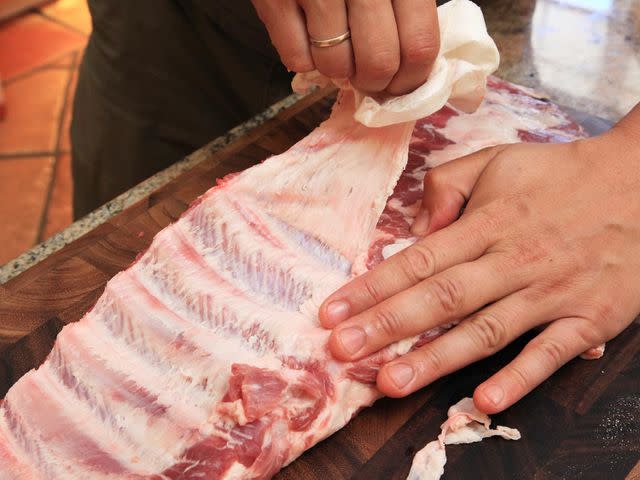
Serious Eats / J. Kenji Lopez-Alt
But even the city’s boarding houses couldn’t eat up the supply. In the early days, one account recalled, "cart loads upon cart loads of spare-ribs" were "drawn to the water’s edge and emptied into the Ohio to get rid of them."
That started to change in the 1870s, when artificial ice-making and then mechanical refrigeration transformed meat packing from a seasonal to a year-round business. Now packers could hang onto spareribs and sell them to retailers as a low-cost cut.
Recipes for spare ribs appear in cookbooks and newspapers with greater frequency in the closing decades of the 19th century. Many advised cutting the ribs into three-bone pieces and parboiling them before seasoning and finishing on a hot gridiron over coals in a kitchen fireplace. Others called for roasting them in an oven over a bed of sauerkraut and serving with applesauce, mashed potatoes, and mustard.
In 1895, the Ottawa Herald (that’s Ottawa, Kansas) contemplated options for Thanksgiving menus and noted, "Turkey and cranberries may cost more than spare ribs and turnips, but a good, well seasoned spare rib baked brown and crisp beats any turkey that ever flapped his wings." But pork ribs weren’t destined to displace the gobbler on the traditional Thanksgiving menu. Instead, they helped transform the way Americans ate their barbecue.
The Rise of the Rib Shack
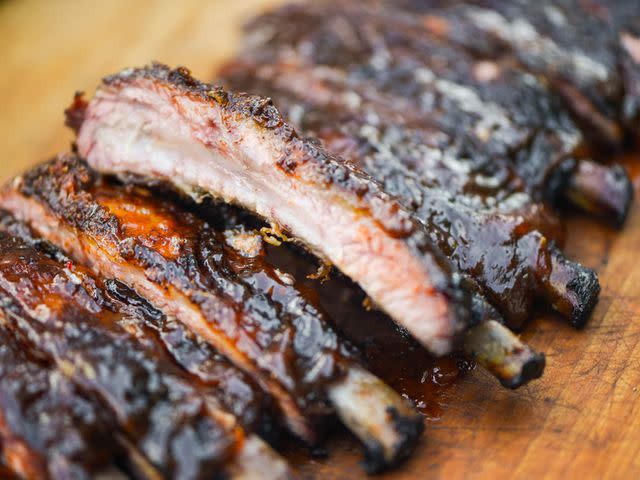
Serious Eats / Joshua Bousel
Before the 20th century, barbecue wasn’t a commercial product. It was served at occasional, large-scale gatherings where whole animals were cooked outdoors on open pits. These events were typically provided free of charge as part of community Fourth of July celebrations or political campaigns.
As the country urbanized, though, entrepreneurial cooks started selling slow-smoked meats on city street corners and in courthouse squares. Often these were farmers who slaughtered one or two of their own pigs, cooked them on a pit, and took the meat into town to sell over the weekend. The first barbecue stands were informal operations—just a tent or temporary shed—but over time they evolved into permanent restaurants, and their operators began offering a regular slate of meats. They increasingly bought those meats from local packing houses instead of raising the animals themselves, and many restaurateurs started buying individual cuts like shoulders and hams instead of whole pigs.
Those local packers had plenty of spare ribs on hand, too, which they were happy to unload for cheap. The historical record doesn’t pinpoint any particular region where barbecued ribs were introduced, nor any particular type of operation. In a matter of a few years, spare ribs could be found all over the country at barbecue stands, cafés, and take-out butcher shops—anywhere that had a barbecue pit and smoked meats to sell to the public.
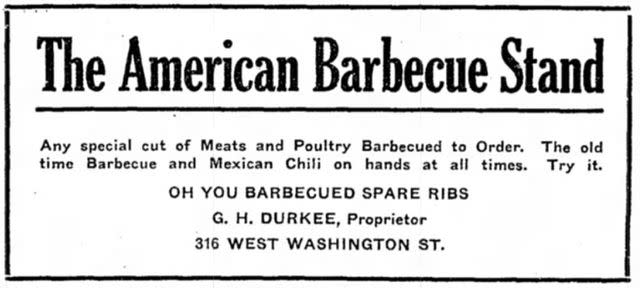
Arizona Republic, Sept 30, 1916
In the 1920s, A.R. Hubbard’s Cafe in Houston offered barbecued ribs alongside dinners and short orders. Clegg’s Hotel and Cafe in Greensboro, North Carolina, featured "barbecued spare ribs with sweet potatoes" for its 75-cent Special Sunday Dinner. Rasmussen’s in Davenport, Iowa, offered "Tennessee Style Barbecue Ribs," which it touted as "inexpensive—with a fine appetizing taste."
Rasmussen’s reference to "Tennessee style" is tantalizing, but I’ve found no other evidence to indicate that rib-cooking was more common in Tennessee than anywhere else. In fact, a surprising number of the stands selling spare ribs were found in Iowa—which, perhaps not coincidentally, was prime hog-producing territory.
One notable rib fan was the famed New York Yankee slugger Babe Ruth. The Yankees swept the St. Louis Cardinals in four games in the 1928 World Series, and the night after the final game, as the Yankees’ east-bound train rolled into Mattoon, Illinois, the Babe entertained his teammates and reporters with "50 pounds of barbecued spare ribs and an amber-color fluid which foamed suspiciously on being poured into serving glasses." (This was in the midst of Prohibition, we should note.)
But you didn’t have to be a star athlete to relish a platter of ribs. In large cities—particularly those with a sizable African-American community—ribs emerged as a late-night staple for the nightclub crowd, as club owners set up small pits behind their establishments and cooked a few racks to sell to hungry revelers. In 1928 the movie editor for the Detroit Times returned from a visit to the East Side to report that "barbecue spare ribs in the doorway emporiums of the black belt" were also drawing in lots of white customers. "Served with a spicy sauce, the ribs are thirst-provoking; and nearby beer spots get a brisk play as a resort, color lines being ignored."
Ribs were a hit among the late-night crowd in Memphis, too. The city’s rib pioneer was John Mills, who in the late 1920s opened a barbecue stand on 4th Street, just around the corner from the famous nightlife district on Beale. He cooked his ribs on a charcoal-fired brick pit in the alley out back and mopped them with a peppery hot sauce. Two decades before Charlie Vergos started selling his now-legendary dry-rubbed ribs at The Rendezvous, Mills was drawing a steady crowd of musicians and celebrities like Kate Smith and Bing Crosby, who always stopped by for ribs when they were in town.
The Golden Age of Ribs
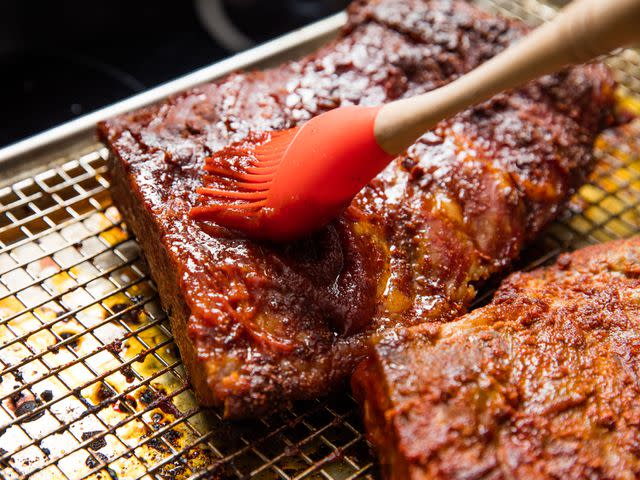
Serious Eats / Vicky Wasik
By the 1930s, barbecued ribs could be found at thousands of barbecue stands, nightclubs, and cafes across the country. In the years just after World War II, ribs crossed over to the menus at high-end restaurants, as well. In 1948, the syndicated food columnist Ida Bailey Allen noted, "People pay fancy prices to nibble at barbecued spare ribs in a swanky restaurant," bemused that a once-humble cut had gone uptown.
Ribs were in high demand for backyard barbecuing, too, as that form of home entertainment surged in the post-War years. In 1955, the New York Times declared, "This increasingly popular cut of meat inevitably will claim the attention of almost every outdoor cook during the summer season ahead." A century before, packinghouses literally couldn’t give ribs away, but now, the Times reported, "their price is in their luxury bracket." Since a pound of ribs served only one diner, effectively "the meat costs more than a sirloin steak or prime rib roast, both of which yield two to three servings per pound."
This same period witnessed the emergence of the so-called St. Louis-style rib. This wasn’t a method of cooking, but rather of cutting the meat to gussy up its presentation. On a full rack of spare ribs, there is a line where each of the long bones ends and a short length of cartilage and fat begins. Butchers in St. Louis took to slicing away the tips (also called the "brisket" or "collar") and removing the short, pointed end of the rack just past the 13th bone. The result was a long, squared-off slab that let diners chew the meat straight off the long bones without worrying about all the cartilage and fat on the ends.
The first mention I’ve found of trimming ribs this way appeared in 1947 in the St. Louis Post Dispatch. It describes the rib-cooking method of Adolph Feiler, the chef at the decidedly swanky Forest Park Hotel, who barbecued ribs on a charcoal rotisserie with electric powered spits, swabbing the meat at frequent intervals with a tomato-based sauce. A photo shows Roscoe Duncan, Feiler’s "first cook," preparing the ribs by removing the tips with a cleaver. "This job is usually done by the butcher," the article noted.
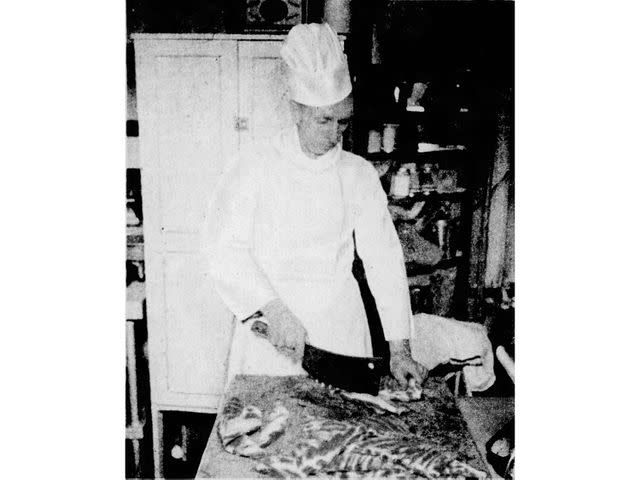
St. Louis’s local meat packers embraced the cut to differentiate their products from those of the national packing houses. In 1995, Elaine Viets of the St. Louis Post Dispatch interviewed retired local butcher Robert F. Eggleston, who recalled that in the post-War era there were 15 to 20 meat-packing establishments around St. Louis. "The major packers cut the spare ribs from the carcass and sold them that way," Eggleston told Viets. "They left on a big hunk of bone and gristle we butchers called the collar. . . The St. Louis packers took off about half that collar. It cost consumers a little more, but it was a better value. Rib lovers bought it. That was the St. Louis cut rib."
The method took off across the country, and by the early 1950s, butchers from California to Mississippi were advertising "St. Louis style" ribs as a premium product. In Brownsville, Texas, in 1951, regular spares sold for 39 cents a pound, while St. Louis style ran for 45 cents. An ad in the Rockville, Illinois, Morning Star described the cut as "Center Strips of Ribs Only / The Brisket Is Removed" and declared them "Perfect for Bar-B-Quing."
Ironically, this innovation led to packers having a new unwanted cut on their hands: the rib tip—that long strip of cartilage, gristle, and meat that had been carved away to pretty up the slab. Once again, barbecue joints came to the rescue. High-end hotels and swanky nightclubs might roast prime St. Louis cuts on motorized rotisseries, but barbecue cooks started buying up the tips and putting them on their old-school pits, letting the magic of smoke and time transform them into something delicious.
Rib tips are now a staple of St. Louis’s traditional barbecue restaurants alongside pork snoots—an even more undervalued part of the hog. In Chicago, which by the turn of the 20th century had eclipsed Cincinnati as America’s hog-packing capital, rib tips were adopted at legendary South Side joints like Lem’s and Argia B’s in the 1950s and 1960s and are now an essential part of the city’s signature style. Connoisseurs know they have to gnaw their way around a little gristle to get to the good stuff, but they swear the meat is tastier and worth the extra effort.
That’s a much better use of leftover pig parts than dumping them in the Ohio River.
July 2019
Read the original article on Serious Eats.

